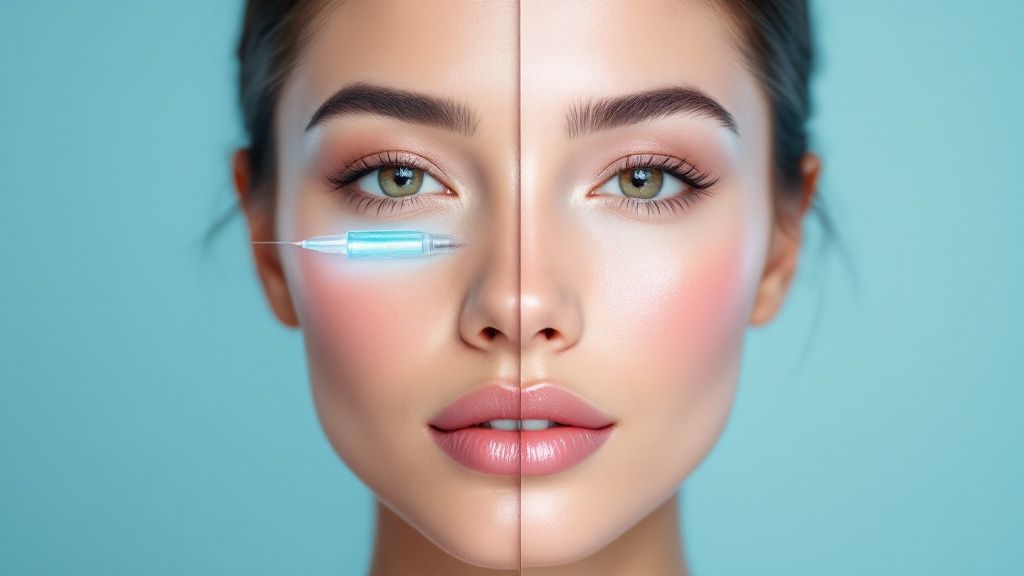
Here’s the simplest way to think about it: Botox relaxes muscles to stop wrinkles caused by your expressions, while dermal fillers add volume to smooth out lines that are always there.
Essentially, Botox stops the cause of the wrinkle, and filler treats the wrinkle itself.
Decoding Botox and Fillers A Quick Comparison
When you're looking into cosmetic injectables, the first question is always, "What's the difference between Botox and filler?" While both are incredibly popular for turning back the clock without surgery, they are not interchangeable. They work in completely different ways to tackle distinct signs of aging.
Botox is what we call a neuromodulator. Its one and only job is to temporarily quiet down the specific muscles that create “dynamic wrinkles”—those lines that pop up when you smile, frown, or raise your eyebrows. By stopping those muscle contractions, Botox smooths out the skin and can even prevent deeper lines from setting in.
Dermal fillers, on the other hand, are soft, gel-like substances, usually made from hyaluronic acid (something your body naturally produces). Their purpose is to restore lost volume, lift and sculpt facial contours, and fill in “static wrinkles”—the lines and folds you can see even when your face is perfectly still. Think of them as physically adding back the plumpness and structure that time has taken away.
This image gives you a great visual breakdown of their key differences, from how fast you’ll see the change to how long you can expect it to last.
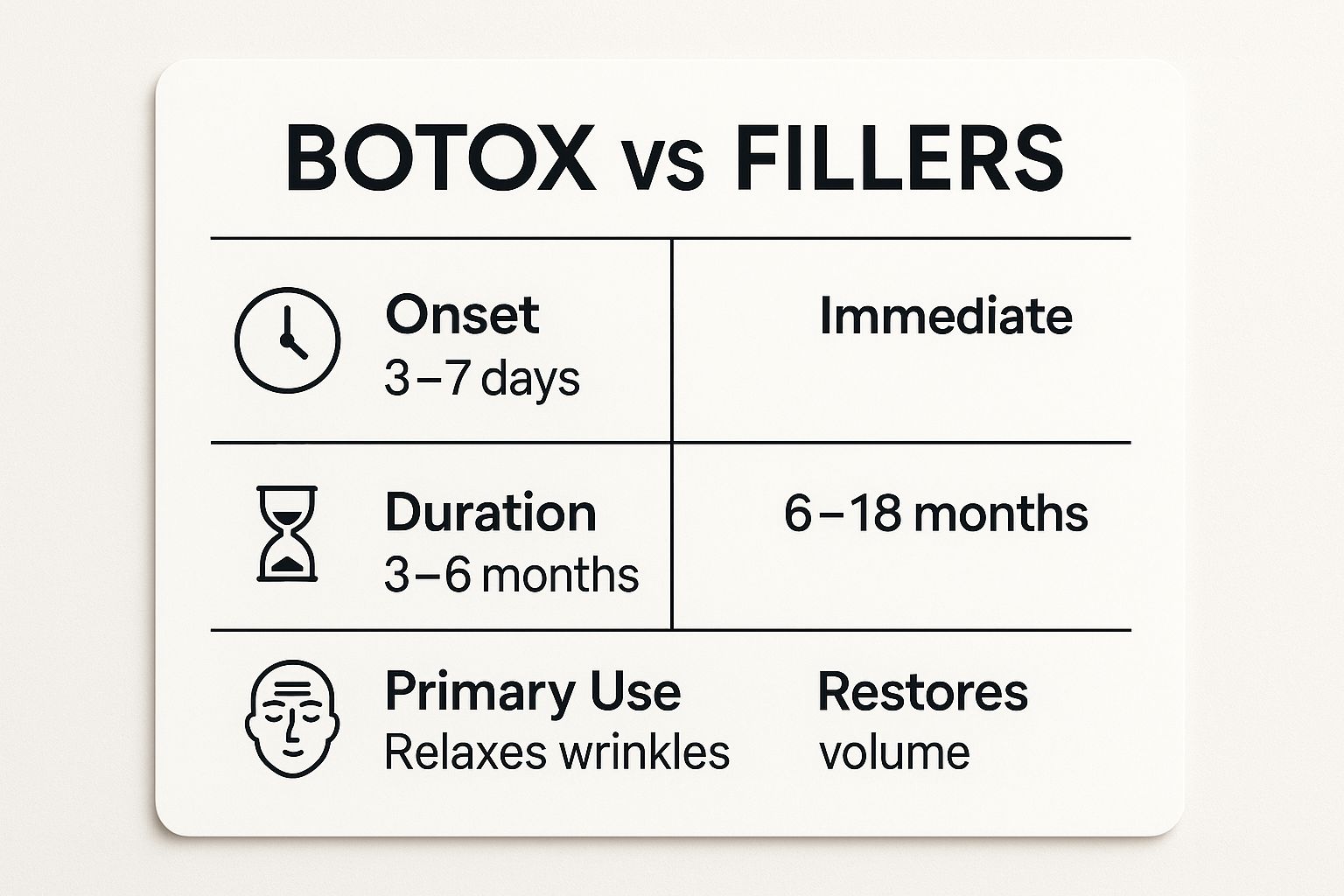
As you can see, fillers give you that instant gratification with a longer-lasting effect, whereas Botox is more of a gradual reveal but is the go-to for expression lines.
Key Differences at a Glance
To make the choice even clearer, here’s a quick side-by-side comparison of their main features. This table helps you see exactly how each treatment aligns with different goals, whether you’re targeting crow’s feet or restoring fullness to your cheeks.
The expert team at BotoxBarb by Barb N.P. can help you create a personalized plan to decide which is best for you.
Key Differences Botox vs Dermal Fillers
This table offers a clear, side-by-side summary of Botox and dermal fillers to help you quickly grasp their core functions and applications.
| Attribute | Botox | Dermal Fillers |
|---|---|---|
| Primary Function | Relaxes muscles to reduce dynamic wrinkles | Adds volume to fill static lines and enhance contours |
| Target Areas | Forehead lines, frown lines, crow's feet | Cheeks, lips, smile lines, under-eye hollows |
| Mechanism | Blocks nerve signals to muscles | Injects a gel to plump and add structure |
| Onset of Results | 3-7 days | Immediate |
| Duration | 3-4 months on average | 6-18 months, depending on the product |
Ultimately, understanding these core distinctions is the first step toward choosing the right treatment to achieve the refreshed, natural look you're after.
How Botox Smooths Expression Lines
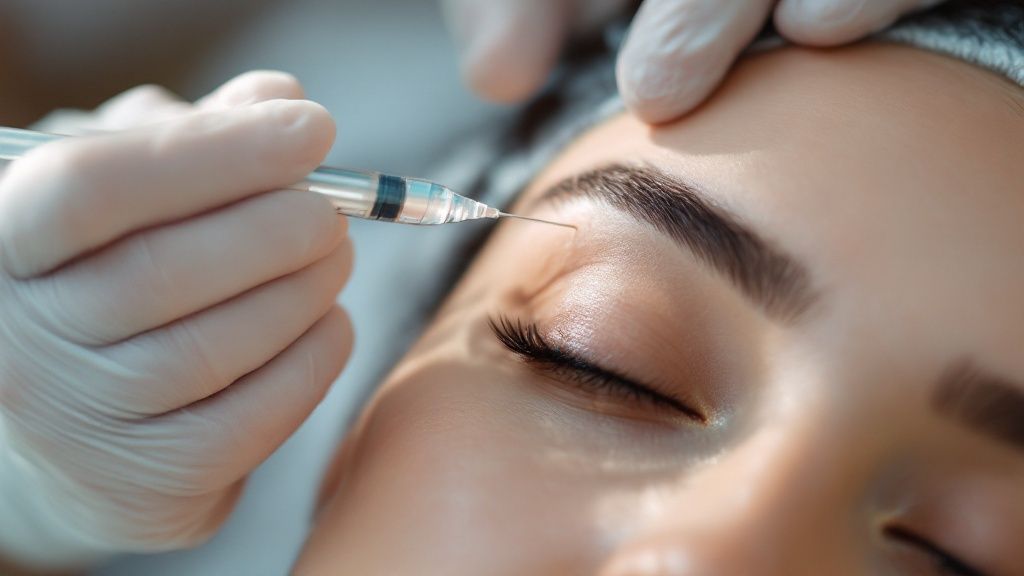
To really get the difference between Botox and filler, you have to understand how they work. Botox is a highly purified protein, a neuromodulator that gets to the root cause of dynamic wrinkles: the muscles themselves. It works by intercepting the nerve signals that tell specific facial muscles to contract.
Think of it as a temporary "off switch" for those overworked muscles. Every time you squint, frown, or raise your eyebrows, the muscles under your skin pull it into folds, creating lines. After thousands of those movements, the lines can stick around for good. Botox simply blocks the "contract now" message from ever reaching the muscle.
The muscle relaxes, and the skin on top smooths out. It’s a beautifully simple and effective way to reduce the appearance of wrinkles tied directly to your expressions.
The Mechanism of Muscle Relaxation
This isn't an instant fix. After your injections, it takes a few days for the Botox to settle in and start blocking those nerve signals. This is why you'll see the smoothing effects appear gradually over 3 to 7 days, with the full, final result visible at about the two-week mark.
Its entire job is to soften lines caused by movement, not to fill in space. That’s the key difference between Botox and dermal fillers, which physically add volume back into the skin. Understanding this is crucial to knowing why Botox is the go-to for certain parts of the face. For a deeper look at the benefits and procedure, you can check out our ultimate guide to achieving natural-looking Botox results.
By temporarily relaxing targeted muscles, Botox not only smooths existing expression lines but also acts as a preventative measure, stopping them from becoming deeper and more permanent over time.
Common Treatment Areas for Botox
Because Botox works on muscle activity, it truly shines in areas where our expressions are most visible. An experienced provider like Barb N.P. precisely targets these muscles to give you a refreshed, rested look without ever sacrificing your natural expressions.
The most common areas include:
- Glabellar Lines: Those "11s" that show up between your eyebrows when you frown.
- Forehead Lines: The horizontal lines that appear when you raise your brows in surprise.
- Crow’s Feet: The fine lines that fan out from the corners of your eyes when you smile.
The numbers back this up. Botox's global market is expected to hit $13.74 billion by 2032, driven by just how effective it is for these muscle-related concerns. In the U.S. alone, there were over 4.7 million Botox procedures in 2023, making it the clear leader in muscle-relaxing injectables.
How Fillers Restore Lost Volume
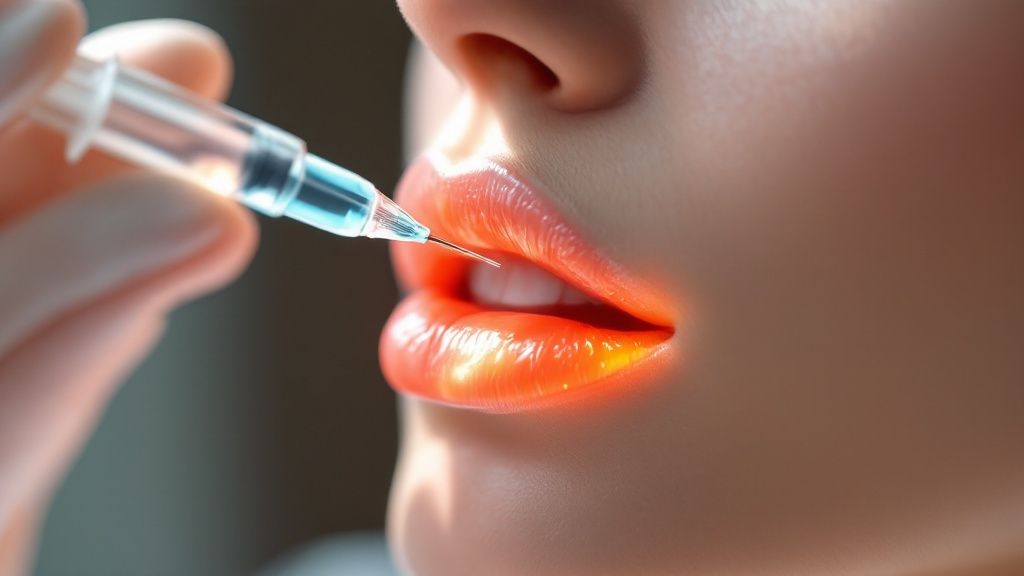
While Botox works on the muscles causing the wrinkles, dermal fillers take an entirely different route. Fillers are injectable gels made to physically add volume and structure right where you’ve lost it, essentially “filling in” lines and hollows from underneath the skin.
This is the biggest difference between the two treatments: Botox relaxes, while filler restores.
Most of today’s top-tier fillers are made from hyaluronic acid (HA), a sugar molecule your body already produces to keep skin hydrated and plump. Age causes our natural HA to deplete, which leads to lost volume and those static wrinkles—the lines you see even when your face is completely still. Fillers give that volume right back, instantly.
An expert provider can use this gel to smooth out deep-set lines, lift areas that have started to sag, and redefine your facial contours for a refreshed, more youthful look.
The Science of Adding Volume
The real art of using fillers comes down to their different formulations. Some are thicker and more robust, perfect for rebuilding structure in the cheeks or sculpting a defined jawline. Others are much softer and more flexible, making them ideal for subtle enhancements in the lips or the delicate under-eye area.
This versatility is what allows for a truly customized treatment. An experienced injector like Barb N.P. will choose the exact right product to create a result that looks natural, balanced, and completely you. To dive deeper into the specifics, check out our guide on how dermal fillers work.
Fillers give you an immediate, visible result by physically lifting and plumping the skin. Unlike Botox, which goes after the muscular cause of wrinkles, fillers address the structural effect of volume loss.
Common Areas Where Fillers Excel
Fillers are the go-to for static wrinkles and any area that has lost its youthful fullness. Their power to add volume makes them the perfect tool for a huge range of concerns that Botox simply can't touch.
Popular treatment areas include:
- Nasolabial Folds: Smoothing the deep "smile lines" that run from your nose to the corners of your mouth.
- Marionette Lines: Lifting the lines that pull down the corners of the mouth, which can create a sad or tired look.
- Cheek Augmentation: Restoring lost volume to the mid-face for a subtle lift and more defined cheekbones.
- Lip Enhancement: Adding volume, definition, and symmetry for a plumper, more balanced pout.
The global dermal fillers market was valued at nearly $6.6 billion in 2025 for a reason—they work. That market is expected to grow to around $9.0 billion by 2035, all thanks to consumer demand and new formulations that give smoother, longer-lasting results.
Choosing the Right Treatment for You
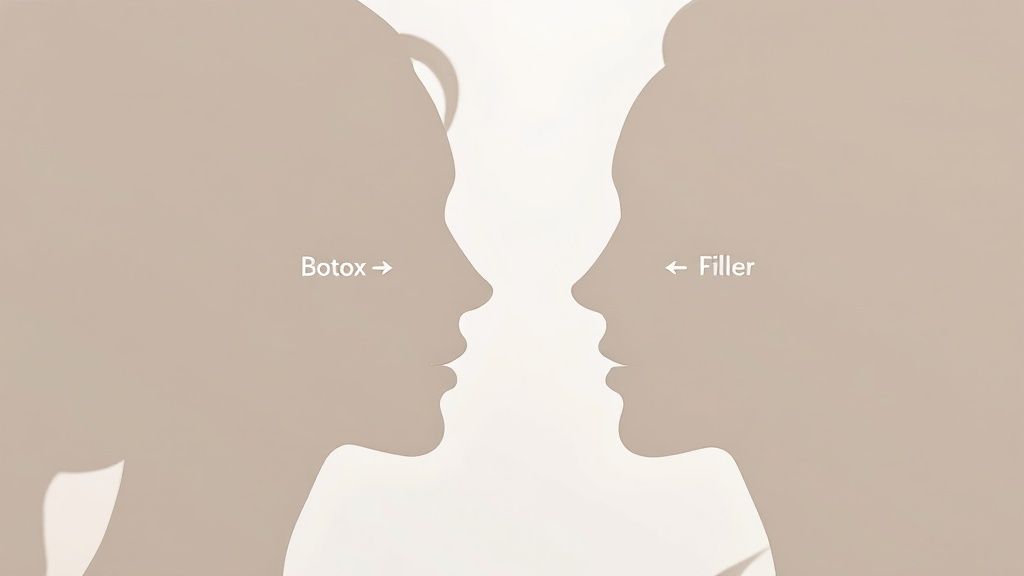
Knowing the science behind Botox and fillers is a great start, but the real question is: what does this mean for your face? Making the right choice really boils down to pinpointing your main concerns, a decision best made with a skilled provider who understands your unique facial structure.
To make that conversation easier, let's look at some real-world scenarios. A quick self-assessment can help you zero in on what you'd like to address, making your consultation far more productive.
Scenario Based Guidance
Take a look in the mirror and think about the specific lines or areas that bother you. How and when those lines appear are the biggest clues. Are they there when your face is at rest, or only when you make an expression? Answering that question is the key to understanding the practical difference between Botox and filler.
Here are a few common examples to get you started:
-
Concern: Forehead Lines When You Raise Your Eyebrows
If you see horizontal lines pop up across your forehead when you're surprised or expressive, that's a classic job for Botox. It works by gently relaxing the frontalis muscle that causes those lines to form. -
Concern: Sunken Cheeks or a Flatter Midface
When the issue is less about lines and more about lost volume or a desire for a subtle lift, dermal fillers are the answer. They physically add structure back to the cheeks, creating a more youthful contour. -
Concern: "11s" Between Your Brows from Frowning
Those two vertical lines that appear when you furrow your brow are pure dynamic wrinkles. Botox is the perfect solution here, targeting the overactive muscles to smooth the skin. -
Concern: Deep Smile Lines from Nose to Mouth
Also known as nasolabial folds, these creases deepen over time due to volume loss in the mid-face. Fillers are used to gently plump the area, softening the folds for a refreshed look.
It often comes down to one simple question: Is your wrinkle caused by muscle movement, or is it from a loss of volume? Your answer will point you directly to the right treatment.
The Power of a Combined Approach
It's crucial to remember that this isn't an either/or decision. In fact, Botox and fillers often deliver the best results when used together. Experienced injectors frequently combine them in what's sometimes called a "liquid facelift" for a truly comprehensive rejuvenation.
For instance, we might use Botox to smooth crow's feet and forehead lines while using fillers to restore cheek volume and sharpen the jawline. This synergistic strategy tackles multiple signs of aging at once, leading to a balanced, natural-looking outcome.
This complementary approach is a major reason the global facial injectable market, valued at $12.53 billion in 2024, is projected to hit $24.9 billion by 2030. This incredible demand shows just how effectively these treatments work together to achieve complete facial harmony. You can find out more about the growth of this market and its trends.
Comparing Results, Longevity, and Cost
Beyond the science, the practical differences between Botox and fillers really come down to timeline and budget. Making the right choice means thinking about how quickly you want to see results, how often you’re willing to come in for maintenance, and what your long-term beauty budget looks like. The financial commitment and the results calendar are two very different stories.
With Botox, patience is key. You won't walk out of the office looking different. Instead, the magic happens gradually over 3 to 7 days as the targeted muscles gently relax. Once the effects fully set in, you can expect that smooth, refreshed look to last about 3 to 4 months. This makes it a recurring treatment, like a standing hair appointment, for those who want to keep dynamic lines at bay.
Dermal fillers, on the other hand, deliver instant gratification. You see the volume and lift right there in the chair. The longevity here is much more of a spectrum, lasting anywhere from 6 months to over two years. It all depends on the type of filler used, where it’s placed, and how your own body metabolizes it.
Breaking Down the Investment
The way these treatments are priced is also completely different, which directly impacts your total cost per session.
Botox is priced per unit. An expert injector like Barb N.P. doesn't just guess; she carefully assesses your facial anatomy to determine the exact number of units needed to soften your crow's feet or forehead lines without "freezing" your expressions. Your final cost is simply the price per unit multiplied by the number of units you received.
Fillers are sold per syringe. The amount you’ll need is tied to the treatment area and your specific goals. For instance, restoring youthful volume to the cheeks might take one or two syringes, but a subtle, natural-looking lip enhancement could require just half a syringe.
Here's the bottom line on cost: A single syringe of filler will always cost more upfront than a typical Botox session. But because fillers last so much longer, they can sometimes be the more cost-effective choice over time for addressing volume loss.
Aligning Your Choice with Your Goals
Ultimately, the best decision is one that fits your budget and your expectations. If you're focused on smoothing away expression lines and prefer a lower initial spend with more frequent touch-ups, Botox is a fantastic and reliable choice. If you want to dive deeper into the timeline, you can learn more about how long Botox results typically last.
But if you’re looking to restore lost volume, want to see immediate results, and are comfortable with a higher upfront investment for a longer-lasting solution, fillers are probably the better fit. A quick chat with your provider about these factors will help map out a treatment plan that feels sustainable and gets you the results you’ll love.
Supporting Your Results with At Home Care
Injectables like Botox and fillers are a serious investment in your appearance, and you absolutely want to protect that investment. What you do at home can make a huge difference, extending the life of your results and boosting your skin's overall health. Even though you now know what is the difference between botox and filler, the strategy for both is the same: support your skin.
Think of your daily routine as the essential maintenance that keeps your results looking fresh. This isn't just about creams and serums; at-home devices can play a powerful role in complementing your in-office procedures by improving your skin from the inside out.
Enhancing Skin Health with LED Therapy
One of the smartest ways to support your injectable results is by bringing LED light therapy into your routine. This technology helps improve overall skin quality, which in turn enhances that smooth, volumized look you paid for.
A fantastic tool for this is the Barb N.P. LED Facial Mask. Its best feature, hands down, is the wireless design—it’s incredibly comfortable and convenient. You aren't tethered to a wall, so you can easily multitask while giving your skin a clinical-grade treatment right from your couch. This makes it easy to be consistent, which is the key to seeing real change.
At-home care doesn’t replace professional treatments. It’s about creating the best possible canvas for them. Healthy, stimulated skin will always show off Botox and fillers more beautifully.
The mask has three different light settings, and each one is designed to tackle different skin needs and help you maintain the beautiful outcome of your treatments:
- Red Light: This is your collagen-booster. It helps firm the skin and improve its elasticity over time, which is perfect for maintaining structure and lift.
- Blue Light: Ideal if you're concerned with blemishes. It effectively targets and reduces acne-causing bacteria for a clearer complexion.
- Amber Light: A soothing option that works to calm inflammation and reduce redness, promoting a more even and balanced skin tone.
By regularly using a device like the Barb N.P. Facial Mask, you're actively working to maintain your skin's integrity. This kind of supportive care ensures the investment you make in Botox or fillers pays off for as long as possible, keeping your skin looking its absolute best between appointments.
Your Top Injectable Questions, Answered
Once you understand the basics of what the difference between Botox and filler is, the next step is usually getting into the practical details. Clients often ask about combining treatments, what it feels like, and what to expect afterward. Here are the answers to the questions I hear most often.
Can I Get Botox and Fillers at the Same Time?
Yes, absolutely. In fact, combining Botox and dermal fillers in a single appointment is a fantastic strategy for total facial rejuvenation. A skilled provider can use Botox to relax expression lines in the upper face (like crow’s feet) while using filler to restore volume to the mid-face (like the cheeks), creating a beautiful, balanced result.
What Is Better for Under-Eye Hollows?
For the hollows or dark circles directly under the eyes—what we call the tear trough area—a hyaluronic acid filler is the definitive answer. This issue is caused by a loss of volume, and filler works by physically adding that volume back, smoothing out the area beautifully. Botox isn't used for this, though a tiny amount can sometimes soften fine lines at the outer corners of the eyes.
The choice between injectables always comes down to the root cause. Is it a line caused by a muscle, or is it an area that’s lost volume? Getting that diagnosis right is the secret to a great treatment plan.
Are Botox and Filler Injections Painful?
Honestly, most people find both treatments very manageable. Botox injections use an incredibly fine needle and feel like a quick, tiny pinch that's over in a second.
For fillers, we typically apply a topical numbing cream before we even start. Plus, most of the modern fillers we use, like those from the Juvederm and Restylane families, are formulated with lidocaine right inside the syringe, ensuring you stay comfortable throughout the whole process.
What Is the Recovery Time for These Treatments?
Both Botox and fillers are famous for having virtually zero downtime, which is why people love them. You can easily fit an appointment into a busy day. After Botox, you might see tiny red bumps at the injection sites, but they usually vanish within an hour. Filler can sometimes cause mild swelling, redness, or bruising, but it’s typically easy to cover with makeup, and you can get right back to your routine.
At BotoxBarb, Barb N.P. provides personalized consultations to help you navigate your options and create a plan that perfectly aligns with your aesthetic goals. To learn more or to book your appointment, visit barbnp.shop.

